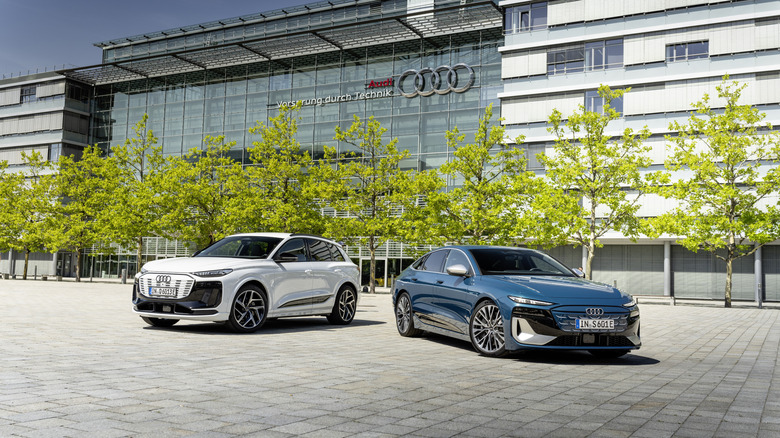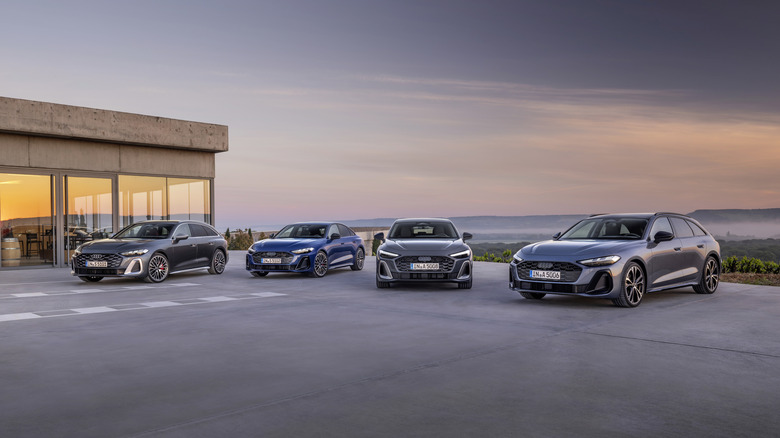Who Makes Audi Cars And Where Are They Built?
Audi as we know it today has been around since 1964 when Volkswagen acquired Auto Union GmbH from Daimler-Benz, but its story began long before. In 1909, with founder August Horch, who established the company and named it Audi — the Latin equivalent of Horch — which means "Listen." Sadly, the company ran into financial difficulties about two decades later and was bought out by Jörgen Skafte Rasmussen's DKW in 1928.
Now, DKW was backed financially by the State Bank of Saxony, which also had interests in other automobile companies. In 1932, the Bank decided to bring all of these businesses together under one umbrella (Audi, DKW, Horch, and Wanderer), marking the beginning of Auto Union AG and the famous four rings logo we now associate Audi with.
It's worth noting that Audi makes its own cars, and its long, storied history is filled with landmark vehicles that marked an era. This is thanks to boundary-pushing features and performances that consistently earn them spots on lists of the best German cars in history. The astonishingly fast Audi R8, for example, stood out for its aesthetically pleasing design and for being the first production car to feature full-LED headlamps. The iconic Audi Sport Quattro and Audi TT are other impressive Audi vehicles that are well-regarded for their design and drivability. But these three aren't alone, and the fact that Audi sold 1.6 and 1.9 million cars worldwide in 2022 and 2023, respectively, underscores the popularity and appeal of its cars in general. Sprawling across nine countries and 16 locations, here's everything you need to know about the manufacturing facilities behind these cars.
Audi has several manufacturing locations in the world
Audi cars are built by Audi Group in 16 locations across 9 countries (18 locations in 10 countries if you count the presumably idle plants), according to information from the Ingolstadt-based automaker. Three of these locations are in Germany, including the Ingolstadt assembly plant (its largest production plant), where the unique Audi Q6 e-tron, A5, A4, A3, and Q2 are built. The Neckarsulm site is another busy German location, as it is responsible for the e-tron GT, A8, A7, A6, A4, and A5 Cabriolet. The Zwickau site, meanwhile, produces only the Audi Q4 e-tron.
Outside of Germany, Audi has a production facility in Brussels that builds that Q8 e-tron, while the Martorell site in Spain makes the legendary Audi A1. Other Audi production locations include Győr, Hungary (Audi Q3); the São José dos Pinhais site;Brazil (Audi Q3); San Jose Chiapa, Mexico (Audi Q5); Chhatrapati Sambhajinagar, India (Audi Q7, Q5, Q3, A6, and A4); as well as Bratislava, Slovakia (Audi Q8 and Q7). In addition, Audi cars are built in six locations in China. These include Anting (Audi A7 L and Q5 e-tron), Changchun (e-tron model series, Q5 L, A6 L, and A4 L), Tianjin (Audi Q3), Qingdao (Audi A3), Foshan (Audi Q4 e-tron, Q2 L e-tron, and Q2 L), and Ningbo (Audi Q6 Roadjet). The Volkswagen Group-owned brand also indicates that it has production facilities in Manaus (Brazil) and Amphur Pluakdaeng (Thailand), but it's unclear if it's currently producing in these locations.

